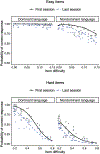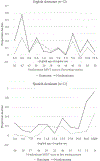Revisiting which language declines more in Spanish-English bilinguals with Alzheimer's disease: Longitudinal decline patterns on the multilingual naming test
- PMID: 38971370
- PMCID: PMC11365789
- DOI: 10.1016/j.neuropsychologia.2024.108948
Revisiting which language declines more in Spanish-English bilinguals with Alzheimer's disease: Longitudinal decline patterns on the multilingual naming test
Abstract
Theories of bilingual language production predict that bilinguals with Alzheimer's disease (AD) should exhibit one of two decline patterns. Either parallel decline of both languages (if decline reflects damage to semantic representations that are accessed by both languages), or asymmetrical decline, with greater decline of the nondominant language (if decline reflects reduced ability to resolve competition from the dominant language with disease progression). Only two previous studies examined decline longitudinally with one showing parallel, and the other asymmetrical, decline. We examined decline over 2-7 years (3.9 on average) in Spanish-English bilinguals (N = 23). Logistic regression revealed a parallel decline pattern at one year from baseline, but an asymmetrical decline pattern over the longer decline period, with greater decline of the nondominant language (when calculating predicted probabilities of a correct response). The asymmetrical decline pattern was significantly greater for the nondominant language only when including item-difficulty in the model. Exploratory analyses across dominance groups looking at proportional decline relative to initial naming accuracy further suggested that decline of the nondominant language may be more precipitous if that language was acquired later in life, but the critical interaction needed to support this possibility was not statistically significant in a logistic regression analysis. These results suggest that accessibility of the nondominant language may initially be more resilient in early versus more advanced AD, and that AD affects shared semantic representations before executive control declines to a point where the ability to name pictures in single-language testing block is disrupted. Additional work is needed to determine if asymmetrical decline patterns are magnified by late age of acquisition of the nondominant language, and if more subtle impairments to executive control underlie impairments to language switching that occur in the earliest stages of AD (even preclinically).
Keywords: Alzheimer's disease; Bilingualism; Language decline; Language dominance; Picture naming.
Copyright © 2024 The Authors. Published by Elsevier Ltd.. All rights reserved.
Conflict of interest statement
Declaration of competing interest None.
Figures


Similar articles
-
Which language is more affected in bilinguals with Alzheimer's disease? Diagnostic sensitivity of the Multilingual Naming Test.Neuropsychology. 2023 Jul;37(5):595-606. doi: 10.1037/neu0000893. Epub 2023 Mar 16. Neuropsychology. 2023. PMID: 36931816 Free PMC article.
-
Distinct structural correlates of the dominant and nondominant languages in bilinguals with Alzheimer's disease (AD).Neuropsychologia. 2019 Sep;132:107131. doi: 10.1016/j.neuropsychologia.2019.107131. Epub 2019 Jul 1. Neuropsychologia. 2019. PMID: 31271821 Free PMC article.
-
Sprinting in two languages: Picture naming performance of older Spanish-English bilinguals on the Multilingual Naming Test Sprint 2.0.Neuropsychology. 2024 Oct;38(7):653-664. doi: 10.1037/neu0000958. Epub 2024 Jul 11. Neuropsychology. 2024. PMID: 38990683
-
Accessibility of the nondominant language in picture naming: a counterintuitive effect of dementia on bilingual language production.Neuropsychologia. 2010 Apr;48(5):1356-66. doi: 10.1016/j.neuropsychologia.2009.12.038. Epub 2009 Dec 29. Neuropsychologia. 2010. PMID: 20036679 Free PMC article.
-
Bilingualism and Dementia: Cognitive Reserve to Linguistic Competency.J Alzheimers Dis. 2019;71(2):377-388. doi: 10.3233/JAD-190397. J Alzheimers Dis. 2019. PMID: 31381516 Review.
Cited by
-
The Association Between Bilingual Animal Naming and Memory Among Bilingual Mexican American Older Adults.J Geriatr Psychiatry Neurol. 2025 Jul;38(4):286-294. doi: 10.1177/08919887241302109. Epub 2024 Nov 19. J Geriatr Psychiatry Neurol. 2025. PMID: 39560120
References
-
- Abutalebi J, Green D, 2007. Bilingual language production: The neurocognition of language representation and control. J. Neurolinguistics 20 (3), 242–275.
-
- Barry C, Hirsh KW, Johnston RA, Williams CL, 2001. Age of acquisition, word frequency, and the locus of repetition priming of picture naming. J. Mem. Lang. 44 (3), 350–375.
-
- Brauer M, Curtin JJ, 2018. Linear mixed-effects models and the analysis of nonindependent data: A unified framework to analyze categorical and continuous independent variables that vary within-subjects and/or within-items. Psychol. Methods 23 (3), 389. - PubMed
-
- Calabria M, Cattaneo G, Marne P, Hernández M, Juncadella M, Gascón-Bayarri J, et al., 2017. Language deterioration in bilingual Alzheimer’s disease patients: A longitudinal study. J. Neurolinguistics 43, 59–74.
-
- Calabria M, Costa A, Green DW, Abutalebi J, 2018. Neural basis of bilingual language control. Ann. N. Y. Acad. Sci. 1426 (1), 221–235. - PubMed
Publication types
MeSH terms
Grants and funding
LinkOut - more resources
Full Text Sources
Medical

